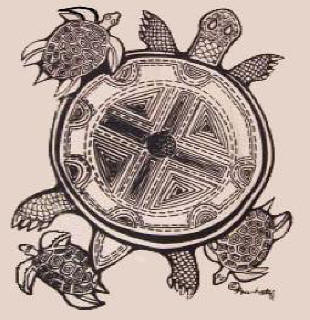 |
LITR 4326
Early American Literature Research Posts 2016 (research post assignment) Research Post 1 |
 |
Michael Bradshaw
One Land, Many Births
During my reading of Native American creation myths, I noticed similar themes
present in many of them. For example, most of these myths can be grouped into
two distinct categories: the "Emergence" story, and the "Earth-diver" story
(White). Also, nearly every Native American creation myth features at
least one or more sentient animals who have the ability to speak, or at least
communicate with humans (White). Lastly these myths promote the idea that man
should be in communion with nature rather than having dominion over it. I will
explore these symbols to find out what these stories can reveal to us about the
various Native American cultures.
As previously stated, many Native American creation stories can be largely
grouped into two main genres: the "Emergence" story, and the "Earth-diver"
story. The Emergence story tells of the creation of the world, and the emergence
of humans (White). These stories, which were prevalent in the Southwestern
United States (White), were often akin to the Genesis story of the
Judeo-Christian religion in which a supreme being creates the world, and then
mankind. Unlike Genesis, the creator in most Native American stories does not
involve itself with with the world after its creation, nor does it impose
mandates or punishment. Mankind does not factor into the plans of its creator
(Ruvolo).
The "Earth-diver" story is an archetype that was prevalent in the Northeastern
United States and Canada (White). Unlike the "Emergence" Stories, the humans are
often already around before the creation of the modern world (Leeming, 12).
Often the world is covered in water, and an animal must dive deep to bring land
from the depths (Yale). This is similar to many flood myths throughout the
world, such as Noah's Ark. However unlike Noah, who only sends the dove out to
find dry land (Genesis 8: 5-12), in Native American stories, the animals often
create the land. This reflects the universal Native American culture of
interdependence with nature rather than the Judeo-Christian belief in the need
to subjugate nature.
Also of note is that the animals in Native American stories are sentient (PBS),
and can speak to humans. Animals are often the heroes of these myths (Leeming,
48), and people often take the form of animals to accomplish their goals,
(Yale). Animals were featured in myths according to geography, (PBS). For
example, the Dakota tribes were so interconnected with the buffalo, that "White
Buffalo Woman" was one of their most revered figures (Ruvolo). Again the
signifies the belief that man is not above nature and must coexist rather than
conquer.
The overarching theme of Native American culture, which is exemplified in their
creation and origin stories is the relationship the tribes had with the
environment. Very few tribes even had a concept of an afterlife where one could
receive reward or face punishment with the Iroquois being a notable exception
(Ruvolo). Even then, the Iroquois did not see the world as needing to be
changed, or nature subjugated. The God of the Judeo-Christian religiion gave the
followers of those faiths dominion over nature. The Gods of the Native
Americans, when they commanded anything at all, desired a balance between man
and nature. Every Native American culture has a tenet of coexistence: one land,
many births, and always striving for balance.
Works
Cited
White, Craig. "Texts for Craig White's Literature Courses." Texts for Craig
White's Literature Courses. University of Houston Clear Lake, 2016. Web. 01
Mar. 2016.
PBS. "Many Voices." Circle of Stories. PBS, n.d. Web. 29 Feb. 2016.
Mendia-Landa, Pedro. "98.02.05: Universal Myths and Symbols: Animal Creatures
and Creation." 98.02.05: Universal Myths and Symbols: Animal Creatures and
Creation. Yale-New Haven Teachers Institute, 2016. Web. 01 Mar. 2016.
Ruvolo, David. "Summary of Native American Religions." Summary of Native
American Religions. West Virginia University, 26 Jan. 1999. Web. 01 Mar.
2016.
"Genesis 8:8-12." Holy Bible: New International Version. Grand Rapids,
MI: Zondervan, 2005. 21-22. Print.
Leeming, David Adams, and David Adams Leeming. Creation Myths of the World:
An Encyclopedia. Vol. 1. Santa Barbara, CA: ABC-CLIO, 2010. Print.
|
|
|
|


